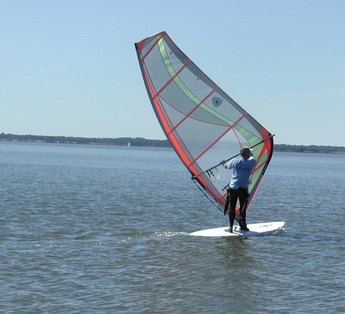What comes after the first lesson?
As you can imagine, there's a lot more to windsurfing than what I've already described here. In subsequent lessons I can teach you a number of somewhat more advanced skills:
Light-Wind Skills: Shortboard Tack, Pivot JibeThe tack (upwind turn) that beginners learn works well on large, floaty boards, but I can also teach you the shortboard tack, or quick tack, which is used in both light and strong winds, and which is mandatory on smaller boards. For this, see this YouTube video.
You should also learn how to turn downwind, which is called jibing (or gybing in British). In lighter winds, one does the pivot jibe, illustrated by me in the video at right. This clip was shot by Andy Brandt during an ABK Boardsports clinic in Dewey Beach, Delaware in October 2009. (ABK clinics always include video analysis so you can see what you're doing right or wrong.) |
|
Moderate-Wind Skill: Beach Start
If there is moderate wind, an alternative to uphauling the sail is the beach start, shown in this video I shot in late June 2011. In this case the wind gusted to just enough strength to get my feet in the footstraps and plane.
|
|
Higher-Wind Skill: Waterstart
If the breeze is strong, in deep water one can do a waterstart, illustrated here. Notice that the sailor does a shortboard tack (mentioned above) right after waterstarting.
|
|
Higher-Wind Skill: Waterstart (again)
Here is another view of a waterstart which I shot in late June 2011.
|
|
Higher-Wind Skill: Planing (Using Harness & Footstraps):
Going fast enough to plane across the surface of the water rather than plowing through it is one of the more thrilling milestones of windsurfing progression. On June 23 2011 the wind was variable, only sporadically enough to plane - but when it WAS strong enough it was ample. Still it took two attempts here to really get going. Note that first the front foot goes into a footstrap, and then the back foot. As I gained speed I gradually was able to straighten my legs to get even more speed.
|
|

